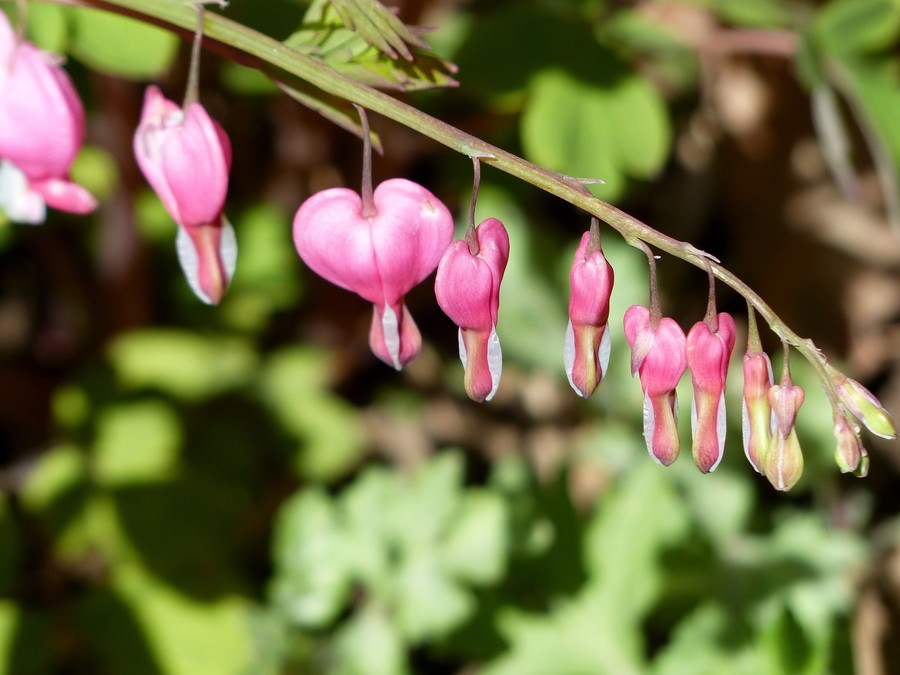Delights of the Bleeding Heart
For those of you who went to school in the fifties and sixties, do you remember how poetry was integral to the curriculum? We had to learn poems by heart and later write them out complete with punctuation and stanza phrasing. This column is about the spring-blooming plant we know as Bleeding Hearts, which recalls the Joyce Kilmer poem “Trees.” The first line of that piece goes, “I think that I shall never see a poem as lovely as a tree.” Bleeding Hearts’ flowers also evoke the line, “I think that I shall never see a flower as wondrous as thee.”
The plant is also known as the Lyre Flower, which is obvious when you examine it closely. This very extraordinary flower is composed of four petals, the outer ones being pink and the inner ones white.
When I first began gardening, I bought a few plants through mail order, which I expected to look like the standard Bleeding Heart with racemes full of flowers. Racemes are long stems with flowers arranged separately and equidistant along the stem. However, those plants did not turn out to be the large flowering versions that I expected. In actuality, I had bought a relative, Dicentra eximia , which is a perfectly nice, low plant with fern-like leaves that still resides in my garden. Unfortunately, it has not proven to be very dynamic in its ability to spread nor has it reseeded itself elsewhere in the garden.
Frankly, if I’m going to buy a plant, I want it to make itself worthwhile by reproducing at a reasonable rate so an initial small investment yields some noticeable return. Hostas are a good example of a plant that is both great in the shade, has many colorful cultivars and can be propagated every few years. Propagation of hostas involves subdivision of the plants. That is a more of an effort than having your plant wildly self-seed themselves, but the result is that I now have so many hosta that I am giving away plants to eager friends.
Incidentally, one of the great benefits of making new friends based on love of plants is that people are delighted to share their surplus and are happy to find someone interested in giving a favorite plant a good home. Sometimes, the name of the plant received may not be clear and it may take some time to make a proper identification.
In any case, the following year, when I happened to be in a garden center and saw some very large Bleeding Heart plants —Dicentra spectabilis (changed to Lamprocapnos spectabilis in 2011 for botanical reasons) — I bought three and carefully planted and watered them. They were indeed lovely as long as they flowered but afterwards they seemed to simply disappear. I decided that enough was enough and whatever they needed I could not adequately provide and I would just move on. You can imagine my surprise the next spring when three even larger plants popped up and they all seemed to be doing very well. It seems that Bleeding Hearts are spring ephemerals — plants that bloom early in the season and then die back once temperatures rise in the summer, only to rebloom the following spring. In the case of Bleeding Hearts, the foliage may remain if it is planted in the shade and receives enough water.
As time and seasons went on, I learned more about these particular plants. One fall, I was digging a hole to plant some new acquisition and was startled to see that I was digging up some unidentified roots. I quickly realized that I must have chosen just the spot where the springtime Bleeding Hearts were growing. Since the damage was already done, I took the root pieces and planted them around my garden hoping that they would just go ahead and do something beneficial for me. It turned out to be a useful experiment since I found healthy Bleeding Hearts all over the property the following spring. I later came to realize that the mature plants were also setting seed when I began to find baby plants all over the garden.
My plants are past peak now, but I still see those wonderful flowers peeking out at me through the surrounding foliage and I look forward to seeing them again upon their return next spring.






